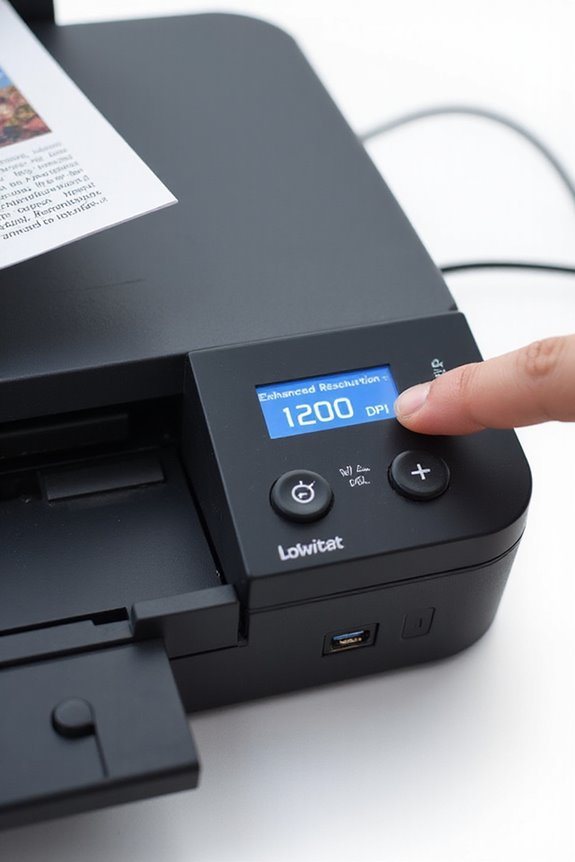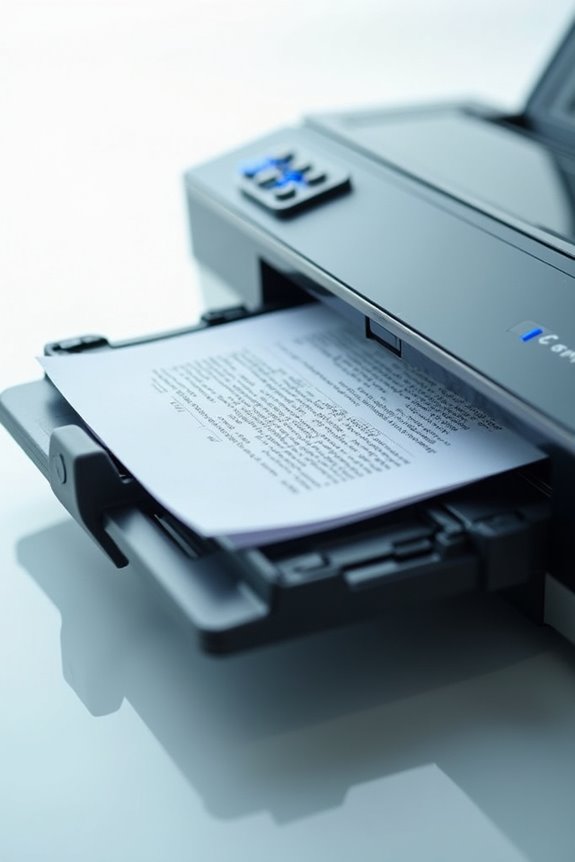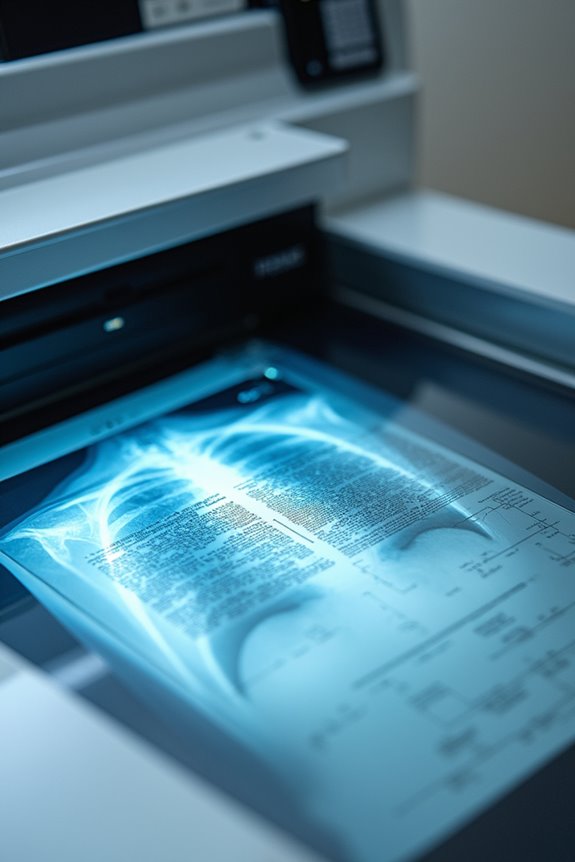To use enhanced resolution scanner technology effectively, we should first select the right scanner based on our specific needs, aiming for an optical resolution of at least 600 DPI. Next, we can optimize scanner settings to balance clarity and file size, adjusting exposure for better image quality. Utilizing image enhancement features, like noise reduction and contrast adjustments, also helps. If we explore additional options and techniques, we can further improve our scanning outcomes.
Key Takeaways
- Choose the appropriate optical resolution (300-1200 DPI) based on document type for optimal clarity and detail capture.
- Regularly calibrate and maintain the scanner to ensure consistent high-quality scanning performance.
- Adjust scanner settings like exposure and color depth for enhanced images, focusing on noise reduction and brightness.
- Utilize image enhancement features such as artifact removal and sharpening to refine scanned images.
- Implement tailored scanner profiles for specific document types to streamline scanning processes and improve efficiency.
Understanding Optical and Interpolated Resolution

When we think about scanning technology, understanding the difference between optical and interpolated resolution is essential. Optical resolution defines a scanner’s true physical ability to capture detail, measured in dots per inch (DPI). This measurement is fixed, directly impacting image accuracy and clarity, especially for photographs or archival documents. For instance, a scanner with a 300 x 300 DPI can detail documents effectively. On the other hand, interpolated resolution is a software-generated enhancement that increases DPI by estimating and adding pixels. While it can improve visuals, it doesn’t add genuine detail, which can mislead users relying solely on these specifications. For tasks demanding precision, prioritizing optical resolution is vital for achieving the best results. Additionally, choosing a scanner with high optical resolution can significantly enhance the quality of scanned images, particularly for professional applications.
Selecting the Right Scanner for Your Needs

How do we guarantee we choose the right scanner for our specific needs? First, we must consider the different scanner types available. For high-volume requirements, we typically want high-throughput models. If we’re dealing with fragile documents, a flatbed option is essential. Then, we assess our resolution needs—standard optical resolutions range from 300 to 1200 dpi. User preferences also play a significant role in our choice, especially regarding color depth, which can be 24-bit or 48-bit. Ultimately, we should look into connectivity options, ensuring compatibility with our existing systems. By evaluating these factors, we can confidently select a scanner that meets our unique requirements and enhances our productivity. Additionally, understanding scanner technology trends can further guide our decision-making process.
Optimizing Scanner Settings for Enhanced Results

Optimizing scanner settings can greatly enhance the quality of our scans and streamline our workflow. First, we should select the appropriate resolution based on our document type: 300-600 dpi for images and 150 dpi for text. Balancing resolution with file size is key to prevent excessively large files that hinder productivity. Implementing scanner profiles tailored to document types can automate these settings, ensuring we always use an ideal resolution balance. For color documents, using the right color mode guarantees accurate reproduction. Also, adjusting exposure metering based on lighting conditions can enhance clarity. Finally, regular maintenance and calibration are essential to maintain performance and prevent errors that might impact our results. Additionally, utilizing automatic document feeders can significantly boost efficiency when scanning multiple pages.
Leveraging Image Enhancement Features

Leveraging image enhancement features can transform our scanning process and greatly improve our output quality. By incorporating noise reduction techniques, we eliminate unwanted distractions, increasing document clarity. We can adjust contrast and brightness to enhance visibility, ensuring every detail stands out. Artifact removal plays an essential role, as it addresses flaws created during scanning, resulting in a polished final product. Additionally, sharpening and clarity enhancement tools refine edges, making text and images more legible. With color accuracy adjustments, we can correct shifts that might detract from professionalism. Overall, these features work together, enabling us to produce high-quality scans that are visually appealing and functional, meeting the demands of our work effectively. Utilizing high optical resolutions allows for even better text recognition results, further enhancing the quality of our scanned documents.
Applications of High-Quality Scanning in Various Fields

High-quality scanning technology finds remarkable applications across various fields, enhancing both efficiency and accuracy. In archives and libraries, it allows for digital archiving of fragile historical materials, making them accessible without damage. We can create detailed metadata through high-resolution scans, improving search capabilities for researchers. In industrial and manufacturing settings, these scans guarantee quality assurance by detecting defects and assuring reliable products. They also support reverse engineering and precise digitization of technical drawings. In the medical field, high-quality scanning enhances diagnostic clarity and secures essential medical records. Overall, high-resolution scans are crucial in preserving quality while improving access, promoting efficiency across diverse sectors. It’s a game-changer we can all benefit from. Additionally, the Digital ICE technology used in high-quality scanners helps remove dust and scratches, further enhancing the clarity of scanned images.
Frequently Asked Questions
How Often Should I Calibrate My Scanner for Optimal Performance?
So, we’re not all scanners, right? Calibration frequency’s key for performance optimization. Heavy users should calibrate weekly, while those of us who’re more moderate can get away with monthly—simple enough to keep things running smoothly!
Can I Use My Scanner With Multiple Operating Systems?
Yes, we can definitely use our scanner with multiple operating systems, provided it has the necessary scanner compatibility and operating system support. Just make sure we have the right drivers and software for peak performance across platforms.
What Is the Lifespan of a Typical Scanner?
The lifespan of a typical scanner ranges from 5 to 10 years, but with effective scanner maintenance tips and understanding scanner lifespan factors, we can greatly extend its useful life, ensuring ideal performance for longer.
How Do I Troubleshoot Common Scanner Issues?
Did you know nearly 30% of scanner issues stem from connectivity problems? We can tackle these together by checking connections and ensuring scanner software updates are current. Troubleshooting goes a long way in ensuring smooth scans.
Are There Eco-Friendly Scanning Options Available?
Yes, there’re eco-friendly scanning options available. By choosing sustainable scanning solutions, we make eco-conscious choices that reduce paper consumption, energy use, and waste, fostering a healthier environment while streamlining our document management practices.





